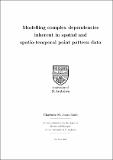Files in this item
Modelling complex dependencies inherent in spatial and spatio-temporal point pattern data
Item metadata
| dc.contributor.advisor | Illian, Janine | |
| dc.contributor.author | Jones-Todd, Charlotte M. | |
| dc.coverage.spatial | xi, 173 p. | en_US |
| dc.date.accessioned | 2017-11-06T15:51:03Z | |
| dc.date.available | 2017-11-06T15:51:03Z | |
| dc.date.issued | 2017-06-23 | |
| dc.identifier.uri | https://hdl.handle.net/10023/12009 | |
| dc.description.abstract | Point processes are mechanisms that beget point patterns. Realisations of point processes are observed in many contexts, for example, locations of stars in the sky, or locations of trees in a forest. Inferring the mechanisms that drive point processes relies on the development of models that appropriately account for the dependencies inherent in the data. Fitting models that adequately capture the complex dependency structures in either space, time, or both is often problematic. This is commonly due to—but not restricted to—the intractability of the likelihood function, or computational burden of the required numerical operations. This thesis primarily focuses on developing point process models with some hierarchical structure, and specifically where this is a latent structure that may be considered as one of the following: (i) some unobserved construct assumed to be generating the observed structure, or (ii) some stochastic process describing the structure of the point pattern. Model fitting procedures utilised in this thesis include either (i) approximate-likelihood techniques to circumvent intractable likelihoods, (ii) stochastic partial differential equations to model continuous spatial latent structures, or (iii) improving computational speed in numerical approximations by exploiting automatic differentiation. Moreover, this thesis extends classic point process models by considering multivariate dependencies. This is achieved through considering a general class of joint point process model, which utilise shared stochastic structures. These structures account for the dependencies inherent in multivariate point process data. These models are applied to data originating from various scientific fields; in particular, applications are considered in ecology, medicine, and geology. In addition, point process models that account for the second order behaviour of these assumed stochastic structures are also considered. | en_US |
| dc.language.iso | en | en_US |
| dc.publisher | University of St Andrews | |
| dc.subject.lcc | QA274.42J76 | |
| dc.subject.lcsh | Point processes. | en |
| dc.subject.lcsh | Probabilities. | en |
| dc.subject.lcsh | Stochastic processes. | en |
| dc.title | Modelling complex dependencies inherent in spatial and spatio-temporal point pattern data | en_US |
| dc.type | Thesis | en_US |
| dc.type.qualificationlevel | Doctoral | en_US |
| dc.type.qualificationname | PhD Doctor of Philosophy | en_US |
| dc.publisher.institution | The University of St Andrews | en_US |
This item appears in the following Collection(s)
Items in the St Andrews Research Repository are protected by copyright, with all rights reserved, unless otherwise indicated.

